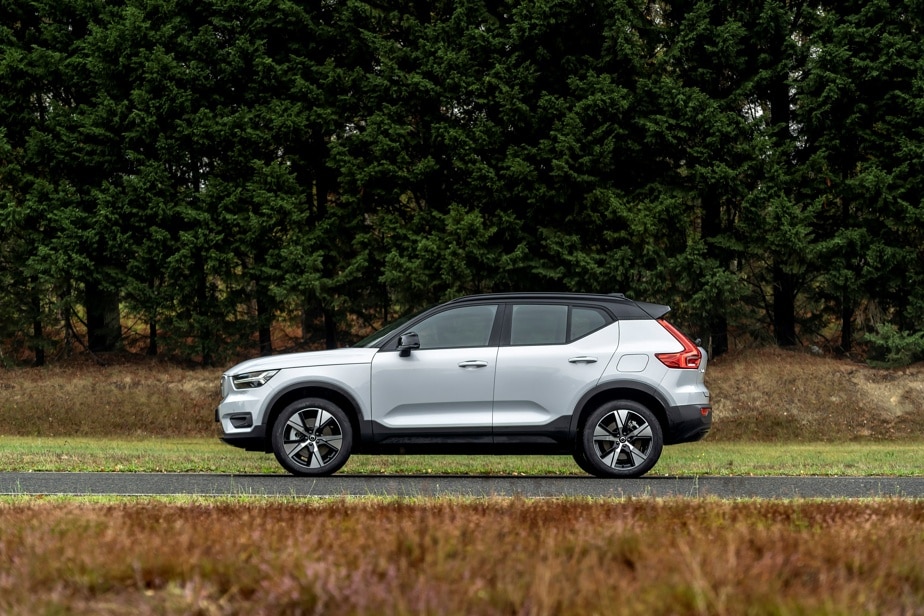Volvo XC40 Recharge: Road Test

In automotive jargon, the term sleeper characterizes a vehicle at first glance very conventional in its behavior, but which is capable of unsuspected performance. Volvo is no stranger to this concept, the manufacturer having created a number of wagons with boiling mechanics, mainly during the 1990s.
The XC40 Recharge, the brand’s first electric vehicle, is the continuation of this idea, except that this time, the sound of the turbocharged five-cylinder and six-cylinder is completely silent.
Contents
Design

PHOTO PROVIDED BY VOLVO
From the side, the XC40’s picked-up look is obvious, with its short overhangs.
The sympathetic face of the XC40, seen for the first time in 2017, remains almost unchanged in its mechanical metamorphosis. When approaching, however, we discover certain details that betray the absence of a combustion engine under the front hood.
The hexagonal grille, for example, is almost completely sealed, to decrease air resistance. Only a small opening is present, at the level of the shield. From the side, the XC40’s picked-up look is obvious, with its short overhangs. We do not observe too great an outbidding of lines, some of which go up towards the rear towards a glossy black roof that seems to float.
Only the mention “Recharge” embossed on the rear pillars specifies its electrical origins. At the rear, the boomerang lights that hug the pillars make Volvo resolutely and the absence of visible exhaust manifold characterizes this livery. Note also the presence of the access hatch to the electrical plug on a wing in the stern of the vehicle, a provision rarely used, but which remains very logical.
On board

PHOTO PROVIDED BY VOLVO
The dashboard design is calming with its beautiful symmetry.
The gasoline variant of the XC40 is an example of modularity. Barely 7 cm longer than a Honda HR-V, the cabin of the small crossover is very ventilated thanks to a good height of roof and a rather abundant glazed surface. The dashboard design is calming with its beautiful symmetry.
The vertical ventilation nozzles adjustable by means of a small metal knob are elegant and give an impression of solidity. That said, for a vehicle priced over $ 60,000, the use of hard plastics is too widespread, despite obvious attention to finish.
We have a lot of space at the front, which is a little less the case behind. There, the problem becomes apparent when the doors are opened, the passengers having to negotiate with large wheel arches. Thanks to the fact that it does not include a thermal engine in the bow, the XC40 has two lockers, one at the front of 21 L, the other of 452 L accessible by a large tailgate.
Under the hood

PHOTO PROVIDED BY VOLVO
The electrical architecture of the Volvo XC40 Recharge concentrates all of its components very low to ensure an equally low center of gravity.
Applying a formula that will become consecrated with the electrification of the vehicle fleet, the XC40 coordinates one motor per axle to provide the momentum. From this configuration, we extract 402 hp and 486 lb-ft of torque, more than double the power of the stock gasoline version.
Thanks to the grip provided by its all-wheel drive and the explosiveness of these small electron-powered mills, the 0-100 km / h sprint is only a matter of 4.9 s. At the wheel, the impression of speed is increased tenfold by the fact that this XC40 rears up in almost total silence, an experience that remains unusual.
In terms of range, the crossover relies on a 78 kWh battery and has a capacity of 335 km. However, it is difficult to correctly estimate these figures, when the system refuses to advance anything before the battery drops to half its charge. Incomprehensible.
Behind the wheel

PHOTO PROVIDED BY VOLVO
You can really enjoy driving this XC40 with a very predictable temperament.
All of the XC40’s powertrain components are positioned very low, an asset for improving road handling and reversing the effects of its weight gain. That said, the first grip first makes us feel a more marked rebound effect than at the wheel of the petrol variants, which is also noticeable at the wheel of the Polestar 2 with which the chassis is shared.
This XC40 would therefore benefit from an additional design phase on the damping to take care of its refinement. Beyond this observation, its handling is exemplary. The sharp changes in trajectory confirm its dynamism, despite its exterior dress which may suggest otherwise.
You can really enjoy driving this XC40 with its very predictable temperament, the all-wheel drive behaving essentially like that of an all-wheel-drive vehicle with a traditional transverse engine. The management supports this temperament with a good mix of assistance, but is not very communicative.
Embedded technologies

PHOTO PROVIDED BY VOLVO
The XC40 Recharge infotainment system developed with Google
Like its cousin at Polestar, this XC40 Recharge has an infotainment system whose frame was designed by Google. Basic Android, therefore, it promises a lot in terms of docking the tech giant’s applications, but gives the impression of being unfinished for the moment.
The absence of Apple CarPlay and Android Auto for a proposal that prides itself on being trendy is curious, but Volvo is promising their arrival in an upcoming update. We can also nowhere inquire about the effects of various variables on the range of the vehicle, but Google Maps gives us the estimated battery charge on arrival when entering a destination.
Moreover, regulars of the brand will be on familiar ground with a vertical touch screen. It should also be noted that semi-autonomous driving is among the most competent in the industry, avoiding the famous unpleasant ping-pong effect between the two lines of tracks.
The verdict

PHOTO PROVIDED BY VOLVO
Volvo’s first foray into the electric world is entertaining thanks to its liveliness and dynamism.
There is no doubt that this XC40 Recharge is an iconoclastic object produced by a builder who is used to it. Based on a harmonious and touching design, Volvo’s first foray into the electric world is entertaining thanks to its liveliness and dynamism. Its size also makes it a vehicle well suited to urban life.
That said, at $ 66,965 and with its range limited to 335 km, this proposition remains quite tucked away. Volvo will probably have to follow the strategy of the Polestar 2, which recently offered a two-wheel drive version to make it more accessible. We also want updates to the system to make it more complete to ensure its technological appeal. A very interesting product, but which will have to be adjusted to look good in front of the new players promised to be more complete.
Notebook
A new, more streamlined version soon
Another electric crossover, the C40, will add to Volvo’s electric family with the same recipe as the XC40, but featuring a slightly more streamlined rear silhouette.
More autonomy for 2022
Thanks to some modifications to the powertrain, the 2022 livery could go 24 km more, for 359 km in all. Volvo specifies that a software update will also increase the range of the 2021 model, without specifying for the moment how much.
A cheaper version to get the discount
The Core version of the XC40 Recharge, which will be offered as of model year 2022, will slightly lower the starting price to $ 59,950, which allows the Quebec government to obtain an incentive of $ 8,000 on purchase.
A four-year subscription to have access to the applications
All XC40 Recharges come with a four-year subscription that allows access to Google apps with data included. However, this makes us captive to internet access when we want to use these applications and we do not yet know the price that will be associated with this subscription when it expires.
One-pedal driving
Like the majority of electric vehicles, this XC40 can be driven only by means of the accelerator pedal. When released, the electric motors return energy to the battery, slowing the vehicle. That said, we cannot adjust the degree of intervention of this feature in its case, as in the Polestar 2.
Technical sheet
- Model under test: Volvo XC40 Recharge
- Motors: two synchronous electric motors with permanent magnets
- Power: 402 ch
- Torque: 486 lb-ft
- Transmission: direct drive by epicyclic gears
- Drive architecture: two electric motors, one per axle
- Estimated range: 335 km
- Price (with options, transport and preparation): $ 66,965 (tested version: $ 73,215)
- Competitors: Audi Q4 e-tron, Ford Mustang Mach-E, Hyundai Ioniq 5 (coming soon), Kia EV6 (coming soon), Nissan Ariya (coming soon) and Tesla Model Y
- New in 2021? New version (Recharge)











